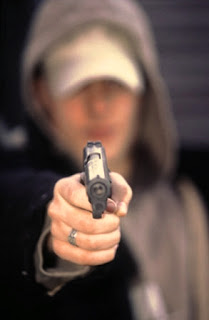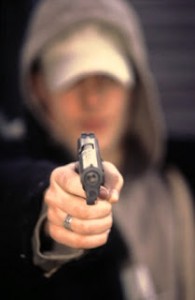
Eyewitness Testimony Part III: Reducing the Rate of Wrongful Conviction
January 9, 2013Student Blogs Article In Parts I and II of this series, I introduced the problem of faulty eyewitness identification, presented the factors currently considered by jurors when weighing eyewitness testimony, and discussed some of the problems surrounding eyewitness confidence as it relates to accuracy. In Part III, I discuss the other Biggers factors, as well as further variables that can influence eyewitness accuracy.
In Parts I and II of this series, I introduced the problem of faulty eyewitness identification, presented the factors currently considered by jurors when weighing eyewitness testimony, and discussed some of the problems surrounding eyewitness confidence as it relates to accuracy. In Part III, I discuss the other Biggers factors, as well as further variables that can influence eyewitness accuracy.
In addition to the confidence of the witness, the Supreme Court has indicated that jurors are to consider the opportunity of the witness to view the criminal, the witness’ degree of attention to the crime, the accuracy of the witness’ prior description of the criminal, and the length of time between the crime and the confrontation. Intuitively, these factors seem to be things that would be relevant when weighing the testimony of eyewitnesses. Empirical research, however, has shown that evaluating the credibility of eyewitness testimony on the basis of these factors is not so simple. Research in the fields of psychology and law has shown, for example, that variables such as the presence of a weapon or the race of the perpetrator can significantly alter the accuracy of the witness.
The “weapon-focus effect” is one phenomenon that can affect witness accuracy regardless of the amount of time that the witness has the opportunity to view the perpetrator. The theory is that when a perpetrator is holding a weapon, the weapon will draw central attention, thus decreasing the ability of the witness to encode and later recall details about the perpetrator’s appearance. The Biggers factors deal only with the opportunity to view the crime itself and are not tailored to account for the presence of a weapon. But it is entirely possible that a witness who has ample time to view a criminal act may be distracted by a weapon, for example, and therefore in no better position to identify the perpetrator than a witness who saw a perpetrator for mere seconds.
Another key factor that is unaddressed by the Biggers guidelines is the racial dynamics between the witness and the perpetrator. A consistent result has emerged in the empirical data showing a strong “own-race bias” or “other-race effect.” The theory is that individuals are much better at identifying people of their own race than those of a different race. Most researchers agree that such a bias exists, but there are multiple theories as to why it exists. One theory is that individuals view being of a different race as a “trait,” but fail to remark on the race of a person who is of their same race. That is to say, if a Caucasian individual views the face of another Caucasian individual, he or she will process nose, eyes, hair color, etc., but when viewing the face of an African American, for example, he or she will process skin color, nose, eyes, hair color, etc. Focusing on this extra trait takes away from the witness’ ability to process, and later recall, the other traits.
Another explanation for the own-race bias is the use of different processing features for same-race versus different-race individuals. There are two ways that individuals process facial features: holistically and featurally. Simply put, holistic processing refers to viewing an individual as a single face, whereas featural processing refers to viewing an individual as a collection of facial traits (i.e. eyes, nose, mouth). Individuals tend to process faces holistically when the subject is of the same race, or if the individual has had a significant amount of exposure to individuals of the suspect’s race. Most importantly, research indicates that recognition of faces is better when processed holistically. Therefore, individuals are better at recognizing subjects of the same race than those of other races, because they process the faces of individuals of other races with a featural orientation. In any event, no Biggers factor takes race into consideration, despite the vast amount of empirical research suggesting that race can vastly alter an eyewitness’ accuracy.
Based on the research concerning eyewitness confidence, the weapon-focus effect, and the own-race bias, there is a strong chance that the Biggers factors do not adequately ensure that jurors weigh the necessary information when determining witness credibility. In the remainder of this series, I will examine whether or not the current Biggers factors violate due process and whether a recent New Jersey Supreme Court ruling may encourage nationwide reform.
You may also like
2 comments
- April 2024
- March 2024
- February 2024
- November 2023
- October 2023
- April 2023
- March 2023
- February 2023
- January 2023
- December 2022
- November 2022
- October 2022
- May 2022
- April 2022
- March 2022
- February 2022
- January 2022
- December 2021
- November 2021
- October 2021
- May 2021
- April 2021
- March 2021
- February 2021
- January 2021
- November 2020
- October 2020
- September 2020
- August 2020
- July 2020
- June 2020
- May 2020
- April 2020
- March 2020
- February 2020
- January 2020
- November 2019
- October 2019
- September 2019
- April 2019
- February 2019
- December 2018
- November 2018
- October 2018
- September 2018
- March 2018
- February 2018
- January 2018
- December 2017
- November 2017
- October 2017
- September 2017
- May 2017
- April 2017
- March 2017
- February 2017
- December 2016
- November 2016
- October 2016
- April 2016
- March 2016
- February 2016
- January 2016
- December 2015
- November 2015
- October 2015
- June 2015
- May 2015
- April 2015
- March 2015
- February 2015
- January 2015
- December 2014
- November 2014
- October 2014
- August 2014
- March 2014
- February 2014
- January 2014
- December 2013
- November 2013
- October 2013
- September 2013
- May 2013
- April 2013
- March 2013
- February 2013
- January 2013
- December 2012
- November 2012
- October 2012
- September 2012
- June 2012
- April 2012
- March 2012
- February 2012
- January 2012
- December 2011
- November 2011
- October 2011
- September 2011
- August 2011
- April 2011
- March 2011
- November 2010
- October 2010
- September 2010

I wonder if the weapon-focus effect and own-race bias are used to possibly discredit eyewitnesses. Do defense lawyers bring in expert testimony to describe these effects to the jury to possibly lower the credibility of the witnesses?
I would think that defense lawyers would definitely bring in experts to testify as to these factors, although their use seems like it would be very limited. For example, in situations where the prosecutor’s case rests almost exclusively on the testimony of one witness, anything to discredit the witness or raise doubts in the juror’s minds would be very helpful to a defense strategy. However, I would assume that the relevance of the expert’s testimony would be drastically reduced as the evidence against a particular defendant continues to accumulate. If there are ten witnesses that this particular defendant did it, the possibility that they may have been mistaken because of the presence of a weapon seems unconvincing.